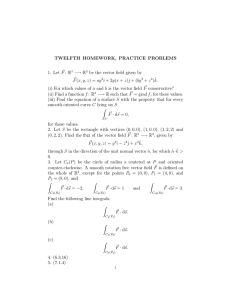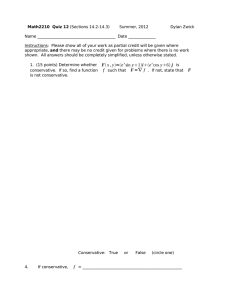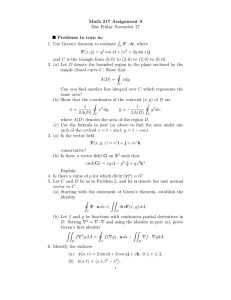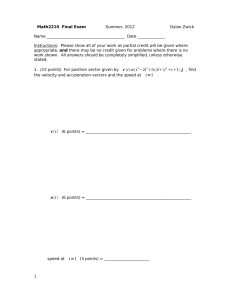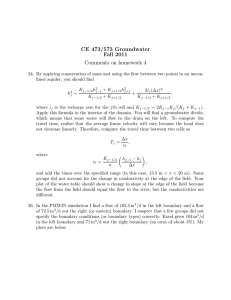17. Vector fields � : A −→ R
advertisement
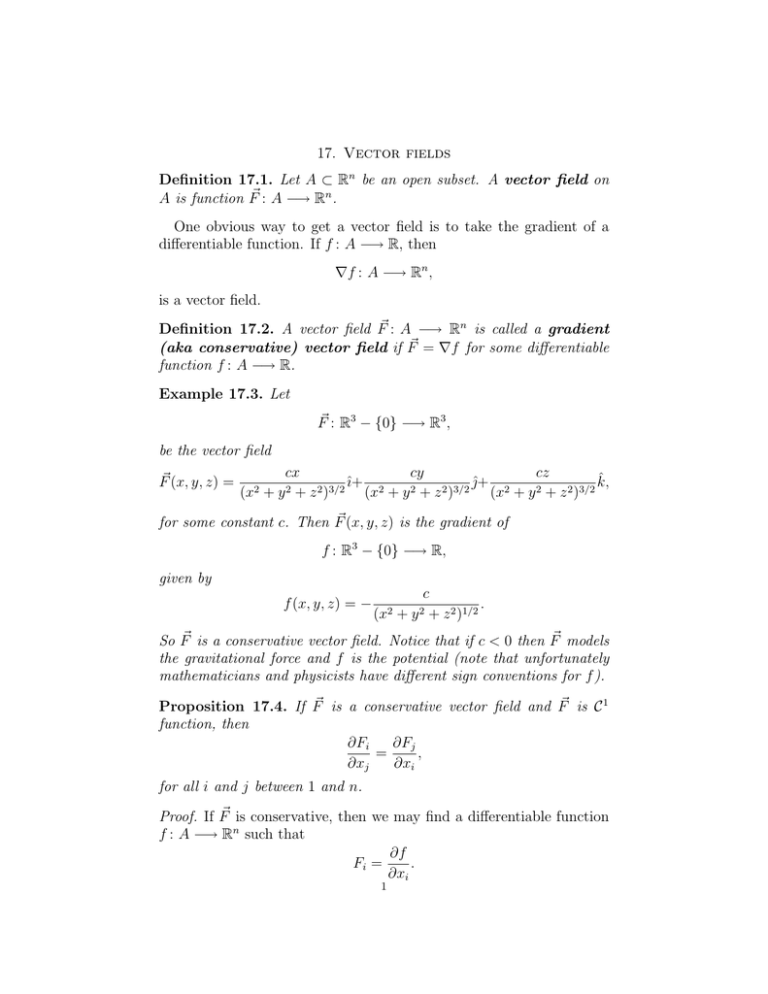
17. Vector fields
Definition 17.1. Let A ⊂ Rn be an open subset. A vector field on
A is function F� : A −→ Rn .
One obvious way to get a vector field is to take the gradient of a
differentiable function. If f : A −→ R, then
�f : A −→ Rn ,
is a vector field.
Definition 17.2. A vector field F� : A −→ Rn is called a gradient
(aka conservative) vector field if F� = �f for some differentiable
function f : A −→ R.
Example 17.3. Let
F� : R3 − {0} −→ R3 ,
be the vector field
F� (x, y, z) =
(x2
cx
cy
cz
ˆ
ı̂+ 2
ĵ+ 2
k,
2
2
3/2
2
2
3/2
2
+y +z )
(x + y + z )
(x + y + z 2 )3/2
for some constant c. Then F� (x, y, z) is the gradient of
f : R3 − {0} −→ R,
given by
f (x, y, z) = −
(x2
c
.
+ + z 2 )1/2
y2
So F� is a conservative vector field. Notice that if c < 0 then F� models
the gravitational force and f is the potential (note that unfortunately
mathematicians and physicists have different sign conventions for f ).
Proposition 17.4. If F� is a conservative vector field and F� is C 1
function, then
∂Fi
∂Fj
=
,
∂xj
∂xi
for all i and j between 1 and n.
Proof. If F� is conservative, then we may find a differentiable function
f : A −→ Rn such that
∂f
Fi =
.
∂xi
1
As Fi is C 1 for each i, it follows that f is C 2 . But then
∂ 2f
∂Fi
=
∂xj
∂xj ∂xi
∂ 2f
=
∂xi ∂xj
∂Fj
=
.
∂xi
�
Notice that (17.4) is a negative result; one can use it show that
various vector fields are not conservative.
Example 17.5. Let
F� : R2 −→ R2
given by
F� (x, y) = (−y, x).
Then
∂F1
= −1
∂y
∂F2
= 1 �= −1.
∂x
and
So F� is not conservative.
Example 17.6. Let
F� : R2 −→ R2
given by
F� (x, y) = (y, x + y).
Then
∂F1
=1
∂y
and
∂F2
= 1,
∂x
so F� might be conservative. Let’s try to find
f : R2 −→ R
such that
�f (x, y) = (y, x + y).
If f exists, then we must have
∂f
=y
∂x
∂f
= x + y.
∂y
and
If we integrate the first equation with respect to x, then we get
f (x, y) = xy + g(y).
Note that g(y) is not just a constant but it is a function of y. There are
two ways to see this. One way, is to imagine that for every value of y,
we have a separate differential equation. If we integrate both sides, we
get an arbitrary constant c. As we vary y, c varies, so that c = g(y)
is a function of y. On the other hand, if to take the partial derivatives
2
of g(y) with respect to x, then we get 0. Now we take xy + g(y) and
differentiate with respect to y, to get
∂(xy + g(y))
dg
x+y =
= x + (y).
∂y
dy
So
g � (y) = y.
Integrating both sides with respect to y we get
g(y) = y 2 /2 + c.
It follows that
�(xy + y 2 /2) = (y, x + y),
so that F� is conservative.
Definition 17.7. If F� : A −→ Rn is a vector field, we say that a
parametrised differentiable curve �r : I −→ A is a flow line for F� , if
�r� (t) = F� (�r(t)),
for all t ∈ I.
Example 17.8. Let
F� : R2 −→ R2
given by
F� (x, y) = (−y, x).
We check that
�r : R −→ R2
given by
�r(t) = (a cos t, a sin t),
is a flow line. In fact
�r� (t) = (−a sin t, a cos t),
and so
F� (�r(t)) = F� (a cos t, a sin t)
= �r� (t),
so that �r(t) is indeed a flow line.
Example 17.9. Let
F� : R2 −→ R2
given by
F� (x, y) = (−x, y).
Let’s find a flow line through the point (a, b). We have
x� (t) = −x(t)
x(0) = a
�
y (t) = y(t)
y(0) = b.
Therefore,
and
x(t) = ae−t
gives the flow line through (a, b).
3
y(t) = bet ,
Example 17.10. Let
F� : R2 −→ R2
F� (x, y) = (x2 − y 2 , 2xy).
given by
Try
x(t) = 2a cos t sin t
y(t) = 2a sin2 t.
Then
x� (t) = 2a(− sin2 t + cost )
=
x2 (t) − y 2 (t)
.
y(t)
Similarly
y � (t) = 4a cos t sin t
=
2x(t)y(t)
.
y(t)
So
F� (�r(t))
.
f (t)
So the curves themselves are flow lines, but this is not the correct
parametrisation. The flow lines are circles passing through the origin,
with centre along the y-axis.
�r� (t) =
Example 17.11. Let
F� : R2 −{(0, 0)} −→ R2
given by
F� (x, y) = (−
x2
y
x
, 2
).
2
+ y x + y2
Then
∂F1
x2 + y 2 − 2y 2
y 2 − x2
(x, y) = −
=
.
∂y
(x2 + y 2 )2
(x2 + y 2 )2
and
∂F2
x2 + y 2 − 2x2
y 2 − x2
(x, y) =
=
.
∂x
(x2 + y 2 )2
(x2 + y 2 )2
So F� might be conservative. Let’s find the flow lines. Try
� �
t
x(t) = a cos
a2
� �
t
y(t) = a sin
.
a2
4
Then
� �
1
t
x (t) = − sin
a
a2
y
=− 2
.
x + y2
�
Similarly
� �
1
t
y (t) = cos
a
a2
x
= 2
.
x + y2
�
So the flow lines are closed curves. In fact this means that F� is not
conservative.
5
MIT OpenCourseWare
http://ocw.mit.edu
18.022 Calculus of Several Variables
Fall 2010
For information about citing these materials or our Terms of Use, visit: http://ocw.mit.edu/terms.


